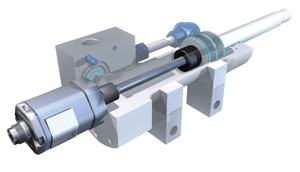The Case for Magnetostrictive
Today’s petrochemical and process industries increasingly depend on higher levels of automation, which in turn require enhanced monitoring and control of valve position and operational readiness.
#automation
Many basic valves employ simple end-of-travel detection with low-cost, electro-mechanical switches and magnetic reed switches. In the case of automatic control valve actuators, a wide variety of position feedback devices are typically used. Some actuators incorporate conventional position measurement technologies such as geared rotary potentiometers, string potentiometers or Linear Variable Differential Transformers (LVDTs).
Magnetic reed switches can break, seize or have contacts that stick together because they hold residual magnetism or become welded in the closed condition by arcing or overload.
Mechanical switches often use an extended lever arm, which is vulnerable to bending or breaking. Also, internal moving parts eventually break or seize, and the contacts may become welded from arcing/overload. Precise adjustment of the switch point can be time-consuming and frustrating.
LVDTs provide absolute position measurement. Although rugged, they often require external processing electronics and are expensive or become technically unfeasible as measured lengths increase.
Geared rotary potentiometers (pots) and string cable-pull pots (encoders) are absolute position-indicating devices. Mechanical and electric wear issues may occur over time, which can lead to noisy intermittent signals or mechanical operational failure.
SHIFT TO MAGNETOSTRICTIVE TECHNOLOGY
There are many reasons the devices are increasingly being selected for demanding industrial applications. They are wear- and maintenance-free because of their non-contact operation, and they are insensitive to extreme environments that may include shock, vibration, temperature swings, contamination, moisture and electrical noise. The absolute output signal does not require homing, even after power interruption, and they come in a wide range of measurement lengths from 1-300 inches (25.4-7,620 millimeters (mm)).
HOW MAGNETOSTRICTIVE WORKS
MLDTs are essentially a time-of-flight device. Using the magnetostrictive principle, a momentary pulse of electrical current is applied to a copper wire that runs the length of a waveguide. The electrical current pulse sets up a temporary magnetic field around the waveguide, which interacts with a permanent magnet acting as a position marker. A phenomenon called the magnetostrictive effect causes a deformation of the waveguide and produces a mechanical wave that travels at a constant ultrasonic speed.
When the wave reaches a signal converter, it is changed from a mechanical deflection to an electrical signal. Precise measurement of the time (down to the picosecond) between the initial pulse and the converted signal reveals the calculated distance to the permanent magnet to a high degree of position accuracy, typically 0.001 inch (25.4 µm) with resolution as fine as 0.0004 inch (1 µm). The update rate is typically 0.5 millisecond (ms) to 1.0 ms depending on the total stroke length (shorter lengths can update faster).
VALVE POSITIONING APPLICATIONS
A common application for MLDTs is with cylinder position feedback for a valve actuator. These transducers can be inserted into a pneumatic or hydraulic cylinder that has a gun-drilled rod. The permanent magnet would be attached to the moving piston. In this application, the MLDT would provide absolute feedback of the piston position inside the cylinder. Cylinders are often applied for linear valve applications for gate or globe valves, but also in quarter-turn rotary applications for ball and butterfly valves that employ actuators to turn linear motion into rotary position (e.g., scotch yoke, helical, and rack and pinion actuators.)
MLDTs also can be mounted externally to the actuator cylinder with a hovering or floating magnet slaved to a moving component on the mechanism. Depending on the application, the gap between the magnetic target and the MLDT sensing element can vary (even during operation) anywhere from 0.00393 inch (0.1 mm) to 0.59 inch (15 mm) without affecting the accuracy of the position reading.
PARTIAL-STROKE TESTING
Partial-stroke testing allows an end user to test emergency shutdown valves while the valve remains in service. Exercising the valve using partial-stroke testing at regularly scheduled intervals allows longer periods of continuous operation between mandatory out-of-service testing. Using an MLDT, the valve can be tested by cycling it momentarily to any position from fully closed to fully open. The MLDT can also provide additional diagnostics such as velocity of the valve actuation. Data logging of the speed of valve movement over time can help detect wear, corrosion or debris in the valve that could affect the fully open or fully closed positions, or cause delayed or slow operation in an emergency.
MLDTs FOR TOUGH APPLICATIONS
MLDTs provide a reliable method for position sensing. There are versions that can survive particularly tough applications from hazardous explosion proof with global certifications to severe wash down with globally rated IP69K (ingress protection rating) requirements. There are many different outputs ranging from fieldbus networks, analog (with voltage and current in various ranges), quadrature, CANopen protocol and more. Few technologies exist that can compete against the hardiness and accuracy of these devices.
Christian Dow is the Energy, Oil and Gas Industry manager for Balluff, Inc. (www.balluff.com) Reach him at christian.dow@balluf.com.
RELATED CONTENT
-
The Rationale Behind Valve Characteristics
Back in the “early days,” we were taught that, to properly control flow, we should select a linear valve characteristic when the valve controls more than 25% of the piping system pressure drop at full flow.
-
Valve Selection for Bypass of Control Valves: A Case Study
A bypass line including a bypass valve is typically installed to provide continuous operation in case of regular maintenance of a control valve.
-
Valve Basics: Electric Actuator Controls
Electric valve actuators control the opening and closing of valves. With a motor drive that provides torque to operate the valve, these actuators are frequently used on multi-turn valves such as gate or globe and also on ball, plug and other quarter-turn valves.












 Unloading large gate valve.jpg;maxWidth=214)